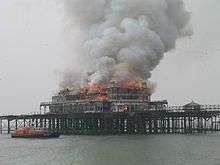Fire services in the United Kingdom
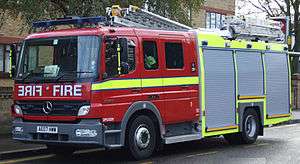

The fire services in the United Kingdom operate under separate legislative and administrative arrangements in England and Wales, Northern Ireland, and Scotland.
Emergency cover is provided by over fifty fire and rescue services (FRS), which is the term used in modern legislation and by government departments.[1] Many FRS were previously known as brigades or county fire services, but almost all now use the standard terminology. They are distinct from and governed by a fire authority, which is the legislative, public and administrative body, made up of civilians (usually members of elected local or regional bodies). Fire authorities in England and Wales (and formerly Scotland), and therefore fire and rescue services, receive a large proportion of their funding through a share of Council Tax. Scotland and Northern Ireland have centralised fire and rescue services, and so their authorities are effectively committees of the devolved parliaments. The total budget for fire services in 2014-15 was £2.9 billion.[2]
Central government maintains national standards and a body of independent advisers through the Chief Fire and Rescue Adviser, which was created in 2007, replacing Her Majesty's Fire Services Inspectorate. The devolved government in Scotland has a similar agency, HMFSI Scotland.
Firefighters in the United Kingdom are allowed to join unions, the main one being the Fire Brigades Union, while chief fire officers (the heads of the various FRS) are members of the Chief Fire Officers Association, which has some role in national co-ordination.
The fire services have undergone significant changes since the beginning of the 21st century, a process that has been propelled by a devolution of central government powers, new legislation and a change to operational procedures in the light of terrorism attacks and threats.
History
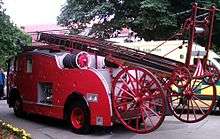
Legislative framework
- See separate article History of fire safety legislation in the United Kingdom
- Comprehensive list of recent UK fire and rescue service legislation:
Legislation (United Kingdom, Great Britain or England and Wales)
Fire services are established and granted their powers under fairly new legislation which has replaced a number of Acts of Parliament dating back more than 60 years, but is still undergoing change; a rough timeline can be seen below.
- 1938: Fire Brigades Act 1938. This Act (which is no longer in force) provided for centralised co-ordination of fire brigades in Great Britain and made it mandatory for local authorities to arrange an effective fire service.[3]
- 1947: Fire Services Act 1947 This Act transferred the functions of the National Fire Service to local authorities. Now repealed entirely in England and Wales by Schedule 2 of the Fire and Rescue Services Act 2004.
- 1959: Fire Services Act 1959 This Act amended the 1947 Act; it dealt with pensions, staffing arrangements and provision of services by other authorities. It was repealed in England and Wales along with the 1947 Act.
- 1999: Greater London Authority Act 1999 This act was necessary to allow for the formation of the Greater London Authority and in turn the London Fire and Emergency Planning Authority.
In 2002, there was a series of national fire strikes,[4][5] with much of the discontent caused by the aforementioned report into the fire service conducted by Prof Sir George Bain. In December 2002, the Independent Review of the Fire Service was published with the industrial action still ongoing; it made radical proposals to how the fire service should be organised and managed. Bain's report ultimately led to a change in the laws relating to firefighting.
- 2002: Independent Review of the Fire Service published[6]
- 2004: Fire and Rescue Services Act 2004,[7] generally only applying to England and Wales.
- 2006: The Regulatory Reform (Fire Safety) Order 2005[8] This piece of secondary legislation or statutory instrument replaces several other acts that dealt with fire precautions and fire safety in premises, including the now defunct process of issuing fire certificates. It came into force on 1 October 2006.[9] The DfCLG has published a set of guides for non-domestic premises:
- 2006: The Government of Wales Act 2006 gave the National Assembly for Wales powers to pass laws on "Fire and rescue services. [and] Promotion of fire safety otherwise than by prohibition or regulation." but does not prevent future legislation being passed by the UK government which applies to two or more constituent countries.
There are further plans to modernise the fire service according to the Local Government Association. Its website outlines future changes, and specific projects:
"The aim of the Fire Modernisation Programme is to adopt modern work practices within the Fire & Rescue Service to become more efficient and effective, while strengthening the contingency and resilience of the Service to react to incidents. "[10]
Select committee
The fire service in England and Wales is scrutinised by a House of Commons select committee. In June 2006, the fire and rescue service select committee, under the auspices of the Communities and Local Government Committee, published its latest report.
Committee report
The committee's brief is described on its website:
The Communities and Local Government Committee is appointed by the House of Commons to examine the expenditure, administration, and policy of the Department for Communities and Local Government and its associated bodies.[11]
Government response
This document, and the subsequent government response[12] in September 2006, are important as they outlined progress on the FiReControl, efforts to address diversity and the planned closure of HMFSI in 2007 among many issues.
Both documents are interesting as they refer back to Professor Bain's report and the many recommendations it made and continue to put forward the notion that there is an ongoing need to modernise FRSs. For example, where FRSs were historically inspected by HMFSI, much of this work is now carried out by the National Audit Office.
Fire Control
On 8 February 2010 the House of Commons Communities and Local Government Select Committee heard evidence on the Fire Control project.[13] Called to give evidence were Cllr Brian Coleman and Cllr James Pearson from the Local Government Association. Also giving evidence Matt Wrack from the Fire Brigades Union and John Bonney Chief Fire Officers Association. The second session heard evidence from Shahid Malik MP Fire Minister, Sir Ken Knight Chief Fire and Rescue Adviser, Shona Dunn Director for Fire and Resilience Department for Communities and Local Government, Robin Southwell CEO and Roger Diggle Project Director EADS. The committee was chaired by Dr Phyllis Starkey MP and attracted significant media attention.[14][15][16][17]
Legislation and administration (England)
Because of the Government of Wales Act 2006, future legislation might be passed that can only affect England.
Legislation and administration (Northern Ireland)
Fire and rescue services in Northern Ireland are provided by a single entity, the Northern Ireland Fire and Rescue Service, a Statutory Corporation funded by the Department of Health, Social Services and Public Safety.
- 1950: When the National Fire Service Northern Ireland was disbanded, three fire authorities took control of firefighting but were unified as the Northern Ireland Fire Authority in 1950.[18] The Fire Services (Amendment) Act (Northern Ireland) 1950 became primary legislation in the same year.
- 2006: Fire and Rescue Services (Northern Ireland) Order 2006 S.I. No. 1254 (N.I.9)[19]
Legislation and administration (Scotland)
Fire services in Scotland are the responsibility of the Cabinet Secretary for Justice in the Scottish Government.[20] Previously the responsibility lay with the Secretary of State for Scotland (the relevant "Secretary of State" referred to in legislation applicable to Scotland).
- 1824: Establishment of municipal fire service in Edinburgh,[21] the first public fire brigade in the UK[22]
- 1885: Creation of Scottish Office transferring administrative (but not legislative) responsibility to Secretary of State for Scotland.
- 1938: Fire Services Act 1938 combined the functions of 185 fire brigades and imposed fire-fighting duties upon local authorities,[23]
- 1941: Fire brigades transferred to National Fire Service (NFS) to form No.11 Region[24]].
- 1947: Fire Services Act 1947 returned fire brigades in Scotland to local authority control,[25] mostly via joint boards. 11 brigades were created[26] resembling somewhat the NFS areas. Section 36 of the Act dealt with its application to Scotland. Parts of the Act remain in force in Scotland.
- 1959: Parts of the UK Fire Services Act 1959 remain in force in Scotland.
- 1996: Creation of additional joint boards consequent to local government re-organisation.
- 1999: Responsibility transfers from Secretary of State for Scotland to the Scottish Executive
- 2002: Consultation Paper: "The Scottish Fire Service of the Future"
- 2003: Consultation Paper: "The Scottish Fire and Rescue Service: legislative proposals".
- 2004: introduction of Fire (Scotland) Bill consequent to 2003 consultation paper.
- 2005: Fire (Scotland) Act 2005 The scope of this act includes a "fire safety regime for non-domestic premises", but it also includes legislation that allows for the provision and operation of fire and rescue services for the eight local authority and joint board FRS in Scotland.[27][28]
- 2012: Police and Fire Reform (Scotland) Act 2012, creating a single Scottish Fire and Rescue Service with effect from 1 April 2013
Legislation and administration (Wales)
- 2006 : The Government of Wales Act 2006 gave the National Assembly for Wales powers to pass laws on "Fire and rescue services. [and] Promotion of fire safety otherwise than by prohibition or regulation.".
Government responsibility for fire services
Central government
Historically, there had been about 1600 local authority fire services under the responsibility of the Home Office in England and Wales until World War II. In 1941, the creation of the National Fire Service brought all UK fire brigades under central government control. The National Fire Service was in turn under the auspices of the Civil Defence Service. Post-war legislation returned control to the Northern Ireland Government, the Home Office (for services in England and Wales) and the Secretary of State for Scotland.
England
The fire service has always been the ultimate responsibility of a government department, historically assisted by an executive agency called Her Majesty's Fire Service Inspectorate or HMFSI,[29] its function was described thus:
"To achieve our vision by education and legislation, in an environment that encourages best practice, equality and diversity, health and safety and best value, and through inspection, to advance the development and continuous improvement of fire brigades."
Directly after the May 2001 general election, control of the fire service in England and Wales passed from the Home Office to the DTLR - or Department for Transport, Local Government and Regions. This department was then broken up creating the Office of the Deputy Prime Minister (ODPM) which took central government responsibility.
In May 2006, the ODPM was re-structured creating the Department for Communities and Local Government or CLG, and it became the central government department for fire authorities in England.[30][31] but would be advised by a new department under the direction of the Chief Fire and Rescue Adviser - see below.
Fire service ministers
The fire service minister is the most senior politician whose brief directly includes fire and rescue issues in England and Wales, other parts of the UK never having had the matter specifically under the control of a UK minister in peacetime. The fire service minister is not part of the prime minister's cabinet. The post is held by a junior minister, or Parliamentary Under-Secretary of State who reports to the secretary of state for Communities and Local Government, who takes ultimate responsibility for fire and rescue, but that is part of a much wider brief.
- Greg Clark: Secretary of State for Communities and Local Government
- Mark Francois: Appointed in 2015 as Minister of State for Fire and Resilience at CLG [32]
Previous ministers
- Angela Smith: A former spokeswoman for Essex Fire and Rescue
- Jim Fitzpatrick, himself a former firefighter in the London Fire Brigade and FBU representative
- Nick Raynsford the minister in charge when legislative control shifted from the Home Office to the Office of Deputy Prime Minister. Mr Raynsford was also the minister during the 2002/3 national strikes
Regional government
Below national level, there are regional and local bodies whose role it is to establish a fire authority, implement the legislation from the tier above, while working alongside the relevant HMFSI and other interested bodies.
- Greater London Authority
- London Fire and Emergency Planning Authority (under direct control of Greater London Authority)
- Metropolitan and county fire and rescue services or brigades - see below
The next level beneath that of local authority, is a brigade which usually comes under the operational command of a high ranking senior officer. Traditionally Chief Fire Officers have risen through the ranks from firefighter, although under modernisation plans brigades can now operate graduate entry, and fast track promotion as is already the case with the armed forces and the police. The London Fire Brigade announced details of its graduate scheme in 2007.[33] Chief Fire Officers (CFO) 'speak' collectively via the Chief Fire Officers Association.
- Fire authority: local councillors elected to set policy on its fire and rescue services, and distribute funding, and approve major spending
- Local authority: Chief executive - overall powers for all an authority's functions, including fire, rescue and resilience
- Brigade: Chief Fire Officer (CFO), Brigade Manager, or (in Greater London) Commissioner - overall operational, strategic and command of a brigade or fire and rescue service
CFOs do attend some operational incidents. Hertfordshire's CFO, Roy Wilsher, took command at the Buncefield oil depot fire in 2005, forming part of the gold command team. If a CFO attends an incident, he will usually be the commanding officer of that incident.
Her Majesty's Chief Inspector of Fire Services (England, Wales and Northern Ireland)
- See main article Her Majesty's Chief Inspector of Fire Services
In England, Wales and Northern Ireland fire services are inspected by what was known as the Fire Service Inspectorate. However, in February 2007, the government announced it was establishing a new unit to provide ministers and civil servants with "independent professional advice on fire and rescue issues". It will be headed by a new role that will be known as the Chief Fire and Rescue Adviser The roles carries the historical function of Her Majesty's Fire Service Inspectorate. The Chief Fire and Rescue Adviser is also title Her Majesty's Chief Inspector of Fire Services. Its role (among others)is to work towards reducing the number of fire deaths in England and Wales, and implement changes to FRS required by the Fire and Rescue Services Act 2004[34] In May 2007, Sir Ken Knight commissioner of the London Fire and Emergency Planning Authority was appointed as the first ever Chief Fire and Rescue Adviser.[35]
Her Majesty's Chief Inspector of Fire Services (Scotland)
In Scotland, the Scottish Fire and Rescue Service is inspected by Her Majesty's Fire Service Inspectorate for Scotland.
Scotland
Except for the period when the National Fire Service existed, matters concerning fire fighting fell within the remit of the Scottish Office (later the Scottish Executive, now the Scottish Government).[36] In Scotland Her Majesty's Fire Service Inspectorate for Scotland (commonly known by the shortened and nationally-unqualified form "HMFSI") exists to inspect all fire Services in Scotland to ascertain how they are discharging their functions under relevant legislation . It functions as an autonomous body under the charge of the Justice Ministry of the Scottish Government[37]
With effect from 1 April 2013 is a single Scottish Fire and Rescue Service (in place of the eight former regional services).
Northern Ireland
Matters concerning fire fighting fell within the remit of the government of Northern Ireland, with two exceptions; the period of the existence of the National Fire Service (Northern Ireland), and the period of direct rule from Westminster when the government of Northern Ireland did not exist.[38][39]
Wales
Responsibility for fire and rescue services and promotion of (but not legislative control of) fire safety in Wales.[40] now lies with the Welsh Assembly Government.[41]
Fire service structure
FRS or brigade-level
Brigades are further sub-divided according to local practice as follows:
- Command: Large brigades, such as the London Fire Brigade, are divided into commands
- Area: A brigade or FRS can also be divided into areas, for example London used to consist of five geographical areas: northwest, north, northeast, southwest and southeast
- Divisional: A smaller geographical area, again it can be decided locally; again London until 1986 consisted of eleven divisions
- Borough: Brigades are now aligned with local councils, and because of London's size, its three commands also overlap with the London boroughs, so each borough is a small division. It now has borough teams,[42] and a separate list of stations shows which borough it belongs to.[43]
Resilience
The Cabinet Office is responsible for the Civil Contingencies Secretariat (CSS),[44] which provides advice for individuals in case of a major disaster:
"The (web)site provides easily understandable guidance for the general public on how to prepare themselves, their families and their homes and businesses to cope during an emergency or disaster."
Any such emergency or disaster is likely to involve a UK FRS, and the generic term for such contingency plans has become known as resilience[45] The 'Preparing for emergencies website' gives specific government advice on fire safety, specific examples include the summer fire safety campaign, and schools' fire safety guide which are just two examples.[46]
Fire service funding
In the UK, an FRS generally provides its services for free, although there are some special services that can be charged for, and some additional services that can be paid for. The service is free to the end user in the case of an emergency.
Funding for the fire service comes from two principal sources: a central government grant, and a small levy on the local council tax. This levy is called a precept.
Modernisation
The need for modernisation
In 2002, Professor Sir George Bain was asked by the government to conduct a wide-ranging review of the fire service in the UK. His report, the Independent Review of the Fire Service, led to rapid changes to fire and rescue services, and was the basis of what eventually became the Fire and Rescue Services Act 2004. Bain's terms of reference were described in September 2002 as follows:
"Having regard to the changing and developing role of the Fire Service in the United Kingdom, to inquire into and make recommendations on the future organisation and management of the Fire Service..."[47]
Bain's report was unpopular with firefighters, and a long period of industrial action started in 2002 and continued until 2003 when a new pay and conditions package was put together.
One of the areas identified by Bain as being in need of modernisation was FRS approach to fire prevention and community fire safety. There is now more emphasis on fire prevention and providing public information coupled with encouraging businesses and individuals to take responsibility for providing a risk assessment of businesses — which became law in October 2006. Additionally, changes to central government, local government, and geographical boundaries have affected the fire service in the UK.
The fire service in England consists of local authority brigades or FRSs, which come under the administrative control of metropolitan and shire, or county fire authorities (e.g. Essex County Fire and Rescue Service).
Most statutory firefighting bodies consist of a fire authority and brigade, the former responsible for political and administrative aspects of service provision and the latter for delivering it. For example, Oxfordshire County Council is responsible for Oxfordshire Fire and Rescue Service. The armed forces, private fire brigades and airports all make their own firefighting provision.
Another area identified in Bain's report was the FRS' capacity to respond to major incidents. Bain's review stated that the fire service should have specific responsibilities for: "Emergency preparedness coupled with the capacity and resilience to respond to major incidents of terrorism and other chemical, biological, radiological or nuclear threats".[47] In England and Wales, three projects are being rolled out that will help the FRS deal with incidents like these. The projects come under the umbrella of the Fire Resilience programme. The programme will provide the FRS with a far greater resilience and control to handle all types of incident.
New Dimension
New Dimension was the first Fire Resilience project to be implemented. It provided FRSs with a wide range of equipment and vehicles to help deal with major challenges like floods and terrorist attacks.
FireLink
FireLink is the new digital FRS wide area communications system in England, Scotland and Wales. The FRS use wide area radios to communicate between vehicles and control rooms but there has never been a fully compatible system. FireLink is more efficient and provides greater resilience for command and control. The fire service's ability to communicate efficiently, across different brigades and with other emergency services has never been easy. The issue was raised by Sir Desmond Fennell, who conducted the public inquiry into the King's Cross fire in 1987. Fennell recommended when his report was published in 1988 that fireground communications be addressed as an issue of "high importance".[48]
FiReControl
Prof Bain's report highlighted many areas of proposed change that include working practices, shift hours and time spent on fire prevention duties. One of the proposals which is now well under way is the reduction of fire service control rooms.
At present, each of England's 45 (the number FRS was reduced from 46 in April 2007 with the merger of Devon and Somerset FRSs[49]) FRSs handles its own calls from either the 999 system or mobile phone companies. Additionally, calls are accepted from the other emergency services by dedicated landlines. The FiReControl project is building nine new purpose-built Regional Control Centres (RCCs). The aim is to rationalise call handling and aim for greater communication between the emergency services.
At present, 999 calls - whether by mobile telephone or landline - are answered by a BT operator, who feeds the call to a fire, police, ambulance, or coastguard Emergency Control Centre as required. Staff, known as control operators or control officers, also despatch the fire appliances, maintain radio communications and provide detailed risk and geographical information. These operators are employed by a FRS, wear a similar uniform to firefighters, and have their own rank structure. The role of specialist fire officers and control operators overlaps where they work jointly in control or command centres, but the subject of mobilising, command and control will change as the FiReControl project advances.
Fire safety
- See separate article History of fire safety legislation in the United Kingdom
Historically fire safety was a function of local authorities rather than the fire service however in 1947 the introduction of the Fire Services Act gave the Fire Brigades their first responsibilities for fire safety. The Fire Precautions Act 1971, the Fire Precautions (Workplace) Regulations 1997 and the Regulatory Reform (Fire Safety) Order 2005 gave more powers to the service.
Today, the modernisation of the UK fire service has taken into account the role that it plays in fire safety issues and that issue is high on the agenda of most fire and rescue services. Many brigades started to produce Integrated Management Plans (IMP) to take into account these new responsibilities and produced plans for not only fire safety in the workplace but also in the community. Now all fire and rescue services have community based fire safety departments.
The Fire and Rescue Services Act 2004 now lays out in Section 6 what the fire service must do. It states that a fire and rescue authority must make provision for the purpose of promoting fire safety in its area and this must include the provision of information, publicity and encouragement in respect of the steps to be taken to prevent fires and death or injury by fire not only by the enforcement of specific fire safety legislation, but also by a proactive strategy targeted at all sections of the community.
Powers
Fire safety statistics in the UK
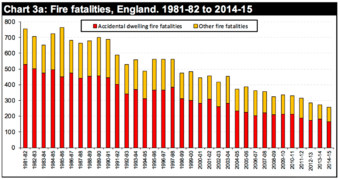
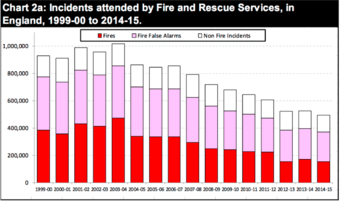
Fires and fire fatalities have dropped significantly in the UK over the past ten years as seen in the graphs to the right.[50]
Incident reporting
Information about each fire incident is collected by each FRS to DCLG standards. The reporting standards include the following parameters:[51]
- Primary or secondary fire - primary fires involve damage to property with an identifiable owner and are coded FDR1. Secondary fires do not and are coded FDR3.
- Accidental or deliberate fire
- Occupancy of dwellings for accidental residential fires: Single Occupancy; Multiple Occupancy (Same); Multiple Occupancy (Different; No Occupancy
- Deliberate secondary fires involving rubbish: domestic wheelie bins; commercial/business refuse bins; fixed/street litter bins; refuse /litter in the open.
- The involvement of children, youths or adults
- The registration plate details where available in relation to vehicle fires
- Identified building names and street locations
Public Fire and Rescue Services in the constituent countries of the UK
England, Wales and Northern Ireland
England
Northern Ireland
Northern Ireland has had a single statutory fire service since 1950.
| Northern Ireland Fire & Rescue Service |
Scotland
Scotland has also had a single statutory fire service since 1 April 2013, with its headquarters in Perth.
| Scottish Fire and Rescue Service |
- See also: History of fire brigades in Scotland
Wales
| Brigade | Principal areas (unitary authorities) covered |
|---|---|
| Mid and West Wales Fire and Rescue Service | Carmarthenshire, Ceredigion, Neath Port Talbot, Pembrokeshire, Powys, Swansea |
| North Wales Fire and Rescue Service | Anglesey, Conwy, Denbighshire, Flintshire, Gwynedd, Wrexham |
| South Wales Fire and Rescue Service | Blaenau Gwent, Bridgend, Caerphilly, Cardiff, Merthyr Tydfil, Monmouthshire, Newport, Rhondda Cynon Taf, Torfaen, Vale of Glamorgan |
Wales saw a reduction in the number of fire brigades on local government reorganisation in 1996, from eight (the number of former administrative counties) to three, made up of groups of the new principal areas.
Crown Dependencies
Although not part of the United Kingdom, the Crown dependencies fire and rescue services operate in close cooperation with, and to the same standards as, the UK fire and rescue services. They are:
- Jersey Fire and Rescue Service
- Guernsey Fire and Rescue Service
- Isle of Man Fire and Rescue Service
Other UK fire and rescue services
There are several specialised and private FRSs in the United Kingdom.
Airport fire services

Private airport fire services in the UK protect all categories of airports and aerodromes. They are usually referred to as Rescue and Firefighting Services. One of the biggest aviation fire services is operated by BAA.[52][53] Non-BAA airports operate their own fire services to comply with legislation which states that airports must be provided with RFFS. One such example is London City Airport; its website describes the principal objective of an airport fire and rescue service: "as to save lives in the event of an aircraft accident or incident".[54] The number and type of firefighting appliances based at an airport will be determined by the airport's category.[55] Airports in the UK are categorised from 1 to 10. A category 10 airport caters for the biggest aircraft; the standards are determined by the Civil Aviation Authority.
Defence Fire and Rescue Service
The Ministry of Defence operates its own fire and rescue organisation. Originally this consisted of a civilian fire service known as the "Defence Fire Service" and the RAF Firefighting and Rescue Service. They were known collectively as the Ministry of Defence Fire Services, but in 2004 were formed into the Defence Fire and Rescue Service. This also includes private contractors brought in to protect sites such as small defence establishments.
The DFRS is the largest non geographical or local authority FRS in the UK, though the training, rank structure and equipment used are similar to that operated by their local authority fire service counterparts.
As a general rule the RAF personnel cover runways or airfields with particular expertise in defusing aircraft munitions,[56] with the civilians covering domestic sites, but there were cross overs and both services could be called to airfield and domestic situations.
Both RAF and defence personnel can serve abroad both in peace time and at war.
Fire services protecting royal properties
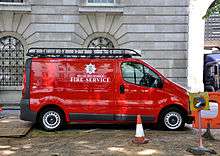
Several state properties, including royal residences and the Palace of Westminster, are protected by their own fire services in the interests of protecting sites of heritage and royal importance. The Royal Household Fire Service is responsible for firefighting at Royal properties.
Private and industrial FRS
Some large factories operate their own private or industrial fire services to protect their interests and provide a first attack capability until local authority fire crews arrive.
BNFL
British Nuclear Fuels and some other nuclear power station operators have their own on-site fire service.
Ports
Several large ports have their own fire service, such as Felixstowe.
Event fire safety services
Several private event fire safety units operate in the UK at major events such as air shows, regattas, concerts and on film sets. They sometimes use the services of off-duty fire fighters and emergency personnel to provide fire cover at outdoor events. The cover normally consists of one or two standard fire appliances with perhaps a rapid response or control vehicle.
See also
- Fire Appliances of the United Kingdom
- Scottish Fire and Rescue Service
- Her Majesty's Fire Service Inspectorate for Scotland
- Historical Fire Brigades of the United Kingdom
- History of fire safety legislation in the United Kingdom
- London Fire Brigade
- Salvage Corps
- UK Firefighter dispute 2002/2003
References
- ↑ Department for Communities and Local Government: Fire and Resilience (accessed 08 Dec 06)
- ↑ "UK Government spending" (PDF). p. 69.
- ↑ Scottish Executive - The Scottish Fire Service of the Future
- ↑ BBC News: countdown to fire strike 13 Nov 2002
- ↑ BBC News: in pictures, Fire Strike in London 14 Nov 2002
- ↑ FRS Online (accessed 02 Sep 07) links to full report PDF: Independent Review of the Fire Service pub Dec 2002
- ↑ Fire & Rescue Services Act 2004, Pub: The Stationery Office, Crown copyright
- ↑ The Regulatory Reform (Fire Safety) Order 2005, England & Wales
- ↑ The Regulatory Reform (Fire Safety) Order 2005 England & Wales, Schedule 4
- ↑ LGA: Fire Service Modernisation
- ↑ House of Commons Communities & Local Govt Committee Fire & Rescue Service, Fourth Report of Session 2005–06, Volume I: introduction
- ↑ Government Response to the Communities & Local Government Committee’s Report on the Fire and Rescue Service, 29 September 2006, TSO
- ↑ "FiReControl - Communities and Local Government Committee Contents". UK Parliament. 8 February 2010. Retrieved 17 April 2010.
- ↑ "FILE ON 4" (PDF). BBC. 2 March 2010. Retrieved 17 April 2010.
- ↑ "FBU denounces failing fire control project as 'the worst ever'". tribunemagazine.co.uk. 19 March 2010. Retrieved 17 April 2010.
- ↑ "Blast for 999 centre delays". Manchester Evening News. 1 April 2010. Retrieved 17 April 2010.
- ↑ "FRS Circular 3/2010 - Fire and Resilience Programme Highlights - January/February 2010". department of communities and local government. 26 February 2010. Retrieved 17 April 2010.
- ↑ Northern Ireland Fire authority: A brief history, by Bill Broadhurst & Harry Welsh (accessed 18 May 07)
- ↑ Fire and Rescue Services (Northern Ireland) Order 2006 S.I. 2006. No. 1254 (N.I.9) (accessed 19 Feb 2007)
- ↑ Scottish Executive - Justice - Fire
- ↑ "General History". Archived from the original on 1 October 2006.
- ↑ Fire Service History
- ↑ Scottish Executive - The Scottish Fire service
- ↑ "NFS". Archived from the original on 1 October 2006.
- ↑ Scottish Executive - The Scottish Fire Service
- ↑
- ↑ Scottish Executive (Justice) Fire Safety (accessed 19 feb 07)
- ↑ Fire (Scotland) Act 2005, Crown copyright, (accessed 23 Feb 07)
- ↑ Dept for Communities and Local Govt, HMFSI
- ↑ Dept for Communities and Local Govt
- ↑ HM Government: Fire Gateway
- ↑ DfCLG Fire and Resilience 09 Aug 07 (accessed 12 Sep 07)
- ↑ London Fire Brigade: Graduates (accessed 03 Jul 07)
- ↑ Department for Communities and Local Government, News Release 022, New Advisory Unit for Fire and Rescue Services to be Set Up, 8 February 2007
- ↑ Communities and Local Government News Release 099, 24 May 2007, New Chief Fire and Rescue Adviser Appointed
- ↑ HMFSI: Scottish Executive
- ↑ Scottish Executive: Justice Her Majesty's Fire Service Inspectorate for Scotland (accessed 30 May 07)
- ↑ Northern Ireland Assembly
- ↑ Northern Ireland Fire and Rescue Service
- ↑ Schedule 7 Government of Wales Act 2006
- ↑ Welsh Assembly Government: Fire
- ↑ LFEPA London Fire Brigade, Borough teams
- ↑ LFEPA London Fire Brigade A to Z of fire stations
- ↑ HM Government, Cabinet Office/CSS 'Preparing for Emergencies'
- ↑ HM Government, Cabinet Office: UK Resilience
- ↑ HM Government, 'Preparing for emergencies', Fire Safety
- 1 2 Independent Review of the Fire Service, online press release 20 Sep 2002, Independent review starts into pay and modernisation of the Fire Service, Accessed 25 Sep 2006
- ↑ [Dept of Transport, Investigation into the King's Cross Underground Fire, pub HMSO, November 1988]
- ↑ Devon and Somerset Fire and Rescue Service web (accessed 2 Sep 07
- ↑ "Fire Statistics Monitor: England April 2014 to March 2015" (PDF).
- ↑ http://gmacdata.agma.gov.uk/singlepoint/help/helpgmfrsdata.html
- ↑ BAA Fire Service (accessed 12 Oct 07)
- ↑ BAA Fighting Fires, Training Firefighters, Nov 2006, (accessed 12 Oct 2007)
- ↑ London City Airport Consultative Committee, Fire and Rescue Service (accessed 16 Feb 2007)
- ↑ Fire Service: Aviation firefighting (accessed 12 Oct 07)
- ↑ Royal Air Force, Careers: firefighter (accessed 16 Feb 07)
External links
- The Fire Service College
- The Scottish Fire Services College
- Her Majesty's Fire Service Inspectorate
- Firefighter Test Preparation
- Her Majesty's Fire Service Inspectorate for Scotland
- UK Fire Service urbans search and rescue dog teams
- Fire Service
- Chief Fire Officers' Association
- Chief Fire Officers Association (Scotland)
- UK Fire News
- Scottish Fire and Rescue Services Procurement - Information for Suppliers
